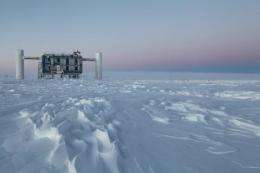Neutrinos put cosmic ray theory on ice

(Phys.org) -- A telescope buried beneath the South Pole has failed to find any neutrinos accompanying exploding fireballs in space, undermining a leading theory of how cosmic rays are born.
IceCube, a detector made up of 5,160 optical sensors embedded up to 2.5km deep in the Antarctic ice, searched for evidence of neutrinos emitted from 300 fireballs, known as gamma ray bursts, observed between May 2008 and April 2010.
In Nature the team behind the experiments report that the search did not find a single neutrino, a result that challenges the idea that cosmic rays originate from gamma ray bursts (GRBs).
Cosmic rays are electrically charged particles, such as protons, that strike Earth from all directions, with energies up to one hundred million times higher than those created in manmade particle accelerators. Understanding their origins would provide crucial insights into the most energetic phenomena in the Universe.
Professor Subir Sarkar of Oxford University’s Department of Physics, who leads the UK involvement in IceCube, said: ‘Although this is a negative result it illustrates that cosmic neutrino detection has come of age – IceCube has achieved the necessary sensitivity to neutrino fluxes expected from likely sources of cosmic rays. It should not be long now before we find the real sources.’
The finding is likely to focus attention on the other prime candidate for creating cosmic rays: the massive black holes found at the centre of active galaxies.
‘The result of this neutrino search is significant because for the first time we have an instrument with sufficient sensitivity to open a new window on cosmic ray production and the interior processes of GRBs,’ said IceCube spokesperson and University of Maryland physics professor Greg Sullivan. ‘The unexpected absence of neutrinos from GRBs has forced a reevaluation of the theory for production of cosmic rays and neutrinos in a GRB fireball and possibly the theory that high energy cosmic rays are generated in fireballs.’
‘Although we have not discovered where cosmic rays come from, we have taken a major step towards ruling out one of the leading predictions,’ said IceCube principal investigator, and University of Wisconsin - Madison physics professor, Francis Halzen.
More information: Nature 484, 351–354 (19 April 2012) doi:10.1038/nature11068
Journal information: Nature
Provided by Oxford University



















